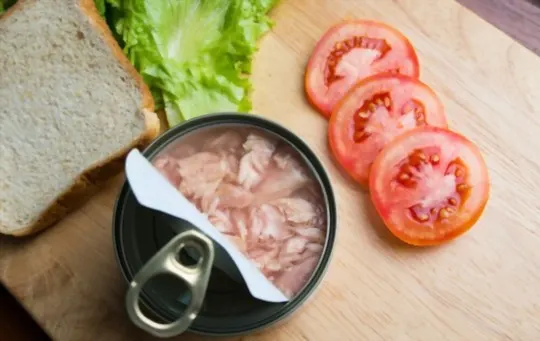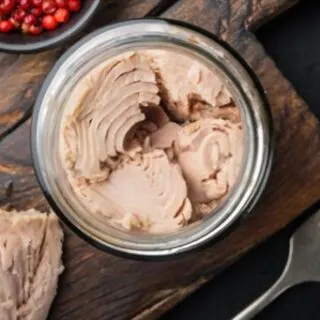Canned tuna can be a great addition to any meal; not only is it versatile, but it’s also convenient and easy to store.
But if you’ve ever been curious about how long your canned tuna will last before it starts going bad, then this blog post is for you!
We’ll explain exactly what the shelf life of canned tuna is and discuss some simple rules to make sure that your tuna doesn’t go bad too quickly.
We’ll discuss the potential risks associated with eating expired or spoiled food—especially when they involve common kitchen ingredients like canned tuna—and provide tips on how best to store food in order to extend its shelf life.
So if you’re planning a dinner using cans of tuna, first settle back and read on – we have all the answers you need!
What’s Canned Tuna?

Canned tuna is a type of fish that is typically packed in oil or water.
It’s a popular food choice for many people because it’s affordable and easy to find.
Canned tuna can be used in a variety of dishes, including salads, sandwiches, and casseroles.
When choosing canned tuna, you’ll want to look for options that are packed in water instead of oil.
Water-packed tuna is lower in calories and fat than its oil-packed counterpart.
You’ll also want to check the label to make sure that the tuna is wild caught and not farm raised.
Wild caught tuna is typically higher in omega-3 fatty acids, which are beneficial for your health.
If you’re looking for a healthy and easy way to add protein to your diet, canned tuna is a great option.
Just be sure to choose wisely and opt for water-packed over oil-packed varieties.
How to Store Canned Tuna?
Canned tuna is a versatile and convenient protein source, but it doesn’t last forever.
Here’s how to store canned tuna to extend its shelf life.
If you’re not going to use your canned tuna right away, store it in a cool, dry place like the pantry.
Canned tuna can be stored at room temperature for up to two years.
Once you’ve opened the can, however, you should consume the tuna within three days.
To further extend the shelf life of opened canned tuna, transfer it to an airtight container and store it in the fridge.
Consume within three days for best quality.
Canned tuna that has been frozen can be stored for up to two months.
Thaw in the fridge overnight before using.
How Long Does Canned Tuna Last?

Canned tuna is a staple in many households – it’s versatile, affordable, and easy to store.
But how long does canned tuna actually last? Does it go bad?
The short answer is that canned tuna can last for up to two years if stored properly.
However, there are a few things to keep in mind that will affect its shelf life.
First, it’s important to note that canned tuna is typically packed in either water or oil.
If you’re storing canned tuna in water, be sure to keep it in a cool, dark place – like the pantry.
If you’re storing canned tuna in oil, on the other hand, it can be kept in the fridge.
Second, once you open a can of tuna, the clock starts ticking.
That means you’ll need to use it within a few days (3-5 days) if you want to ensure it doesn’t go bad.
And when we say “go bad,” we mean that the quality of the tuna will start to decline – it won’t necessarily make you sick.
So there you have it.
Canned tuna can last for up to two years as long as it’s stored properly (in a cool, dark place for unopened cans; in the fridge for opened cans).
Just be sure to use it within a few days once you open the can to ensure the best quality.
Can You Freeze Canned Tuna?
Canned tuna is a versatile and convenient protein source, but you may be wondering whether it’s safe to freeze.
The good news is that you can freeze canned tuna, and it will be just as safe and nutritious as when it was originally canned.
However, there are a few things to keep in mind when freezing canned tuna.
First, the quality of the tuna may suffer somewhat after being frozen and thawed.
The texture may become mushy, and the flavor may be less intense.
For this reason, it’s best to use frozen canned tuna in dishes where these qualities won’t matter, such as in casseroles or soups.
Second, canned tuna is usually packed in water or oil.
If you’re freezing canned tuna packed in water, make sure to drain the water before freezing.
Otherwise, the water will expand as it freezes and could cause the can to burst.
If you’re freezing canned tuna packed in oil, there’s no need to drain the oil first.
With these considerations in mind, freezing canned tuna is a perfectly safe and easy way to extend its shelf life.
How to Tell If Canned Tuna Is Bad?

Canned tuna is a versatile and convenient food, but it doesn’t last forever.
How can you tell if your canned tuna has gone bad?
The first thing to look for is signs of spoilage.
If the can is bulging or dented, or if the contents are leaking, it’s best to discard it.
Also, check for any off-putting smells before opening the can.
If the tuna smells fishy, sour, or otherwise unpleasant, it’s best to throw it out.
Once you open the can, take a look at the tuna itself.
If it looks discolored or has an off odor, it’s best to discard it.
If the tuna looks and smells fine, it’s safe to eat.
If you’re not sure whether the canned tuna is safe to eat, err on the side of caution and throw it out.
It’s better to be safe than sorry.
Conclusion
Canned tuna is a versatile and affordable protein option that can be enjoyed in many different ways.
While canned tuna has a long shelf life, it will eventually go bad.
Pay attention to the expiration date on the can and watch for signs of spoilage, such as a bad smell or a change in color.
If canned tuna is properly stored and not past its expiration date, it can be enjoyed for months to come.

How Long Does Canned Tuna Last? Does it Go bad?
Ingredients
- Canned tuna
- Air-tight containers or Ziplock bags
- Labels and markers
Instructions
- Store your product in an labelled container in a cool, dark place like the pantry or fridge.
- If your food is frozen, allow it to thaw in the fridge before cooking.
- Make sure to look for signs that your food has gone bad before eating it.

Carrie is a food writer and editor with more than 15 years of experience. She has worked for some of the biggest names in the food industry, including Bon Appétit, Food & Wine, and Martha Stewart Living.
As the Editor in Chief of IntroChicago.com, Carrie oversees all of the content on the site. She also manages the team of contributing writers and editors, who help to create delicious recipes, helpful tips, and informative articles that you’ll find on the site.
A native of the Chicago area, Carrie is passionate about all things food. She loves trying new restaurants and experimenting with new recipes in her kitchen. She’s also a graduate of the Culinary Institute of America, so she knows a thing or two about food!
